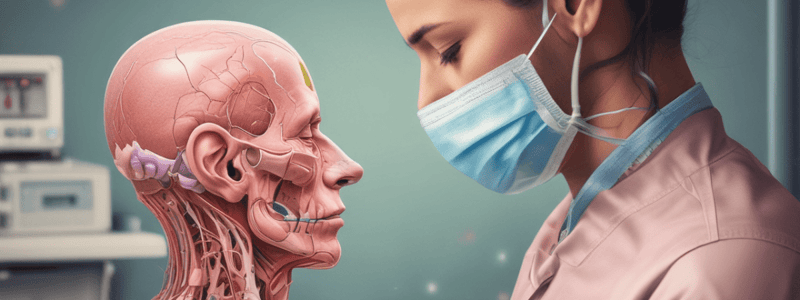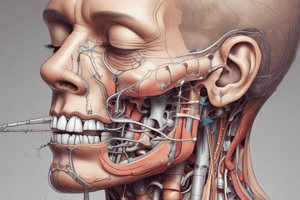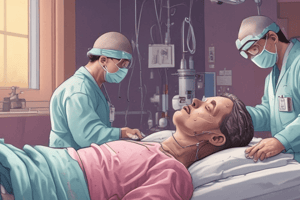Podcast
Questions and Answers
What is the reported percentage of myocardial contusion in autopsy series of patients with blunt cardiac injury?
What is the reported percentage of myocardial contusion in autopsy series of patients with blunt cardiac injury?
- 20-40%
- 60-100% (correct)
- 80-90%
- 40-60%
What is the common site of blunt aortic injury?
What is the common site of blunt aortic injury?
- Descending aorta
- Aortic arch
- Aortic root
- Isthmus, near ligamentum arteriosum (correct)
What is the mortality rate in patients with blunt aortic injury if left untreated?
What is the mortality rate in patients with blunt aortic injury if left untreated?
- 50% in 24 hours
- 30% in 6 hours
- 70% in 1 week (correct)
- 85-95% overall
What is the most common mechanism of blunt aortic injury?
What is the most common mechanism of blunt aortic injury?
What is a radiographic feature associated with thoracic aortic injury?
What is a radiographic feature associated with thoracic aortic injury?
What is the management option for blunt aortic injury?
What is the management option for blunt aortic injury?
What is the common presentation of patients with blunt aortic injury?
What is the common presentation of patients with blunt aortic injury?
What is the treatment for myocardial rupture?
What is the treatment for myocardial rupture?
What is the approach for tracheobronchial tree injuries based on the location and extension?
What is the approach for tracheobronchial tree injuries based on the location and extension?
What percentage of thoracic deaths are attributed to thoracic injury worldwide?
What percentage of thoracic deaths are attributed to thoracic injury worldwide?
What is the management for acute foreign body in the airway?
What is the management for acute foreign body in the airway?
What is a characteristic of pediatric thoracic injuries?
What is a characteristic of pediatric thoracic injuries?
What is the most common site of esophageal injuries?
What is the most common site of esophageal injuries?
What is the primary goal of initial evaluation in thoracic trauma?
What is the primary goal of initial evaluation in thoracic trauma?
What is the timing of surgical repair for esophageal injuries?
What is the timing of surgical repair for esophageal injuries?
What is a common associated injury with flail chest?
What is a common associated injury with flail chest?
What is the most common type of diaphragmatic injury?
What is the most common type of diaphragmatic injury?
What is the primary mechanism of injury in falls, MVA, and crush injuries?
What is the primary mechanism of injury in falls, MVA, and crush injuries?
What is the investigation of choice for diaphragmatic injuries?
What is the investigation of choice for diaphragmatic injuries?
What is a characteristic of sternal fractures?
What is a characteristic of sternal fractures?
What is the complication of esophageal injuries?
What is the complication of esophageal injuries?
What is the primary goal of the secondary survey in thoracic trauma?
What is the primary goal of the secondary survey in thoracic trauma?
What is the management for foreign body in the esophagus?
What is the management for foreign body in the esophagus?
What is a common cause of death in thoracic trauma?
What is a common cause of death in thoracic trauma?
What is the pathology of blunt cardiac injuries?
What is the pathology of blunt cardiac injuries?
What is the frequency of cardiac injuries?
What is the frequency of cardiac injuries?
Flashcards are hidden until you start studying
Study Notes
Tracheobronchial Tree Injuries
- Can be managed conservatively or surgically depending on the location and extent of the injury
- Surgical approach depends on the location of the injury:
- Cervical collar incision: proximal trachea
- Right postero-lateral thoracotomy: lower trachea, carina, right main bronchus (RMB), and proximal left main bronchus (LMB)
- Left postero-lateral thoracotomy: distal LMB
- Options for management: primary repair, sleeve resection, and lung resection
Foreign Body in the Airway
- Management: acute cases require urgent bronchoscopy with or without bronchotomy, while chronic cases require bronchoscopy with precaution and possible lung resection
Esophageal Injuries
- Rare in blunt trauma, more common in penetrating trauma (stab or trans-mediastinal gunshot injury)
- Cervical esophageal injuries are most common
- Clinical features:
- Pneumothorax (left)
- Haemothorax without rib fractures
- Lower sternum or epigastric pain (severe blunt trauma)
- Particulate matter in the ICD
- Penetrating injury that has crossed the mediastinum
- Odynophagia
- Dysphagia
- Surgical emphysema
- Mediastinitis
- Investigations:
- Combination of clinical suspicion, CXR, water-soluble contrast swallow, and oesophagoscopy
- Management:
- Timing: debride and drain within 24 hours
- Surgical repair or resection with delayed reconstruction
- Via:
- RPLT 4th ICS for upper esophagus
- LPLT 6th ICS for lower esophagus
- Complications:
- Mediastinal contamination
- Abscess formation
- Empyema thoracis
Foreign Body in the Esophagus
- Types: bone, meat, battery, coin
- Clinical presentation:
- Acute: dysphagia, choking, hematemesis
- Chronic: hemoptysis, coughing when feeding
- Management: oesophagoscopy with or without mediastinal drainage and repair
Diaphragmatic Injuries
- Often occult, easily missed; left diaphragm most commonly detected
- Marker of severe thoracoabdominal trauma
- Types: blunt vs penetrating (stab/iatrogenic-ICD)
- Clinical features:
- With or without signs of bowel obstruction
- Drainage of peritoneal content via chest drain
- NGT in the chest (CXR)
- Herniation of GIT
- Acute, delayed, common left
- Investigations:
- CXR: elevated hemidiaphragm, haemo-pneumo
- Swallow and follow through
- Contrast-enhanced CT scan
- Management: surgical repair via thoracotomy vs thoraco-abdominal incision vs laparotomy, or laparoscopy
Cardiac Injuries
- Penetrating: myocardial contusion, valve injuries, IVS rupture
- Blunt: myocardial contusion, valve injuries, IVS rupture
- Frequency of injury: 20-25% of thoracic deaths worldwide
- Male vs female: male dominance
- Age: bimodal distribution
- Mechanism of injury:
- Penetrating: high-velocity (gunshots) or low-velocity (stab wounds)
- Blunt: direct (assault and blast) or indirect (falls, MVA)
- Transfixing
Syllabus
- Chest wall (muscle and bone)
- Pleura
- Lung parenchyma
- Tracheobronchial tree (and foreign body)
- Esophagus (and foreign body)
- Diaphragm
- Cardiovascular
Thoracic Trauma
- Thoracic injury accounts for 20-25% of thoracic deaths worldwide
- Male vs female: male dominance
- Age: bimodal distribution
- Mechanism of injury:
- Penetrating: high-velocity (gunshots) or low-velocity (stab wounds)
- Blunt: direct (assault and blast) or indirect (falls, MVA)
- Transfixing
Initial Evaluation
- Goal: prompt identification of life-threatening injuries
- Pathology:
- Airway obstruction
- Loss of oxygenation or ventilation
- Hypovolemia
- Obstructive shock
- Ventilation-perfusion mismatch
- Physiological causes of death:
- Tissue hypoxia
- Hypercarbia
- Metabolic acidosis
Acceleration-Deceleration
- Shearing, tearing, and traction forces in relation to structures being more fixed than others
- Aorta, heart, and esophagus are more susceptible to injury
Initial Evaluation
- Primary survey (Airway-Breathing-Circulation):
- Airway obstruction
- Tension pneumothorax
- Open pneumothorax/sucking chest wound
- Flail chest
- Massive haemothorax
- Cardiac tamponade
- Secondary survey (with the aid of imaging, record every injury from head to toe, systemically)
Traumatic Rib Fractures
- Other bony fractures of the chest wall
- Sternal fractures:
- Up to 4%
- Transverse, in the upper or midportions
- Associated injuries: myocardium
- Clinical features: point of tenderness, swelling, and deformity
- Investigations: ECG, cardiac enzymes, formal ECHO/TEE
- Management: supportive, surgical (help wean off MV)
Studying That Suits You
Use AI to generate personalized quizzes and flashcards to suit your learning preferences.




